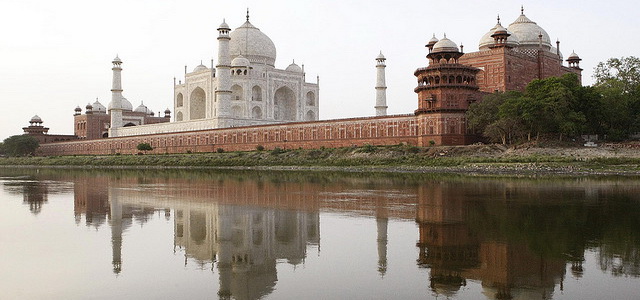| Quick Facts: | Yamuna River |
|---|---|
| Countries: | India |
| Source: | Yamunotri Glacier in Himalaya |
| Mouth: | Ganges River in Allahabad |
| Length: | 1.376 km (855 mi) |
| Basin: | 366.223 km² (141.399 sq mi) |
Location and General Information on the Yamuna River
Yamuna River (also known as Jumna), is the major tributary of the Ganges River. The 1,376 km long Yamuna flows solely through India, crossing three states: Uttarakhand, Uttar Pradesh and Haryana. The Yamuna also flows part of the border between the states of Himachal Pradesh and Uttarakhand and later on its course between the states of Haryana and Uttar Pradesh. The Yamuna rises in the high Himalaya, in the Yamunotri Glacier, at the height of 4,421 meters. It then flows onto the North Indian Plain, describing a broad arc convex to the southwest along its course. The Yamuna joins the Ganges in Triveni Sangam, a sacred Hindu site.
Yamuna River has many tributaries over its 1,376 km course. Near Dehradun, the capital city of Uttarakhand, the Yamuna is joined by its biggest tributary, the Tons River. The Chambal River is Yamuna’s biggest tributary on the right. Other important tributaries of the Yamuna include the Hindon, Sarda and Giri river on the right and Betwa and Sindh on the left.
Economic Importance
Although the Yamuna River is not navigable, it is of great economic importance to India. There are several canals on the Yamuna that irrigate extensive tracts on both banks. The long, narrow, fertile region between the Yamuna and the Ganges, the Doab, is almost fully irrigated. Besides this, Yamuna also partly supplies the water for big Indian cities like Delhi or Agra.
Yamuna River Pollution
With over 50 million people dependent on the water of the Yamuna along with rapid population growth, the Yumuna has developed into one of the most polluted rivers in the world. New Delhi, the capital of India, dumps much of its waste into the river, generating almost 2 million liters per day of sewage. Another issue is that the water remains stagnant for almost 9 months a year, leaving the sewage to rot leaving a thick white foam that covers much of the river around New Delhi. India has spent almost $500 million in cleanup efforts but the Yamuna River continues to be polluted at a huge scale due the magnitude at which pollutants enter the Yamuna on a regular basis.
Tourism at the Yamuna River
There are many interesting spots on the Yamuna that are worth visiting. The first attraction worthwhile visiting on the Yamuna would be Yamunotri, right next to Yamuna’s source. Yamunotri is situated at an 3,293 meter altitude, but offers scenic views. There are many interesting cities on Yamuna’s way too like Delhi or the city of Agra, where the world-renowned Taj Mahal is located.
Religious Importance
The Yamuna is a sacred river for Hindi. Yama is the Goddess of the Yamuna River, the sister of Yama, god of death. Also, on the night of Krishna’s birth, it is said he crossed the Yamuna River, which parted to make place for him to cross the turbulent waters. Yamunotri temple, a shrine dedicated to the goddess, Yamuna is one of the most prominent shrines in Hinduism, representing the Chota Char Dham Yatra circuit.





